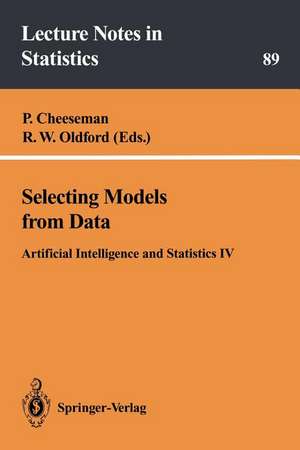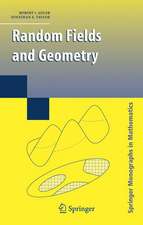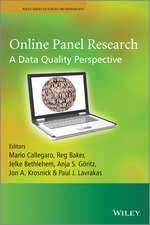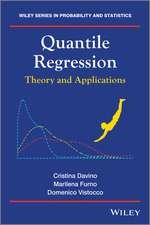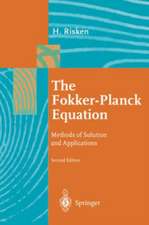Selecting Models from Data: Artificial Intelligence and Statistics IV: Lecture Notes in Statistics, cartea 89
Editat de P. Cheeseman, R. W. Oldforden Limba Engleză Paperback – 27 mai 1994
Din seria Lecture Notes in Statistics
- 15%
 Preț: 631.86 lei
Preț: 631.86 lei -
 Preț: 385.84 lei
Preț: 385.84 lei - 17%
 Preț: 490.19 lei
Preț: 490.19 lei - 17%
 Preț: 460.28 lei
Preț: 460.28 lei - 18%
 Preț: 945.92 lei
Preț: 945.92 lei - 20%
 Preț: 561.42 lei
Preț: 561.42 lei - 18%
 Preț: 943.25 lei
Preț: 943.25 lei - 18%
 Preț: 943.25 lei
Preț: 943.25 lei - 18%
 Preț: 995.97 lei
Preț: 995.97 lei - 15%
 Preț: 641.38 lei
Preț: 641.38 lei -
 Preț: 436.14 lei
Preț: 436.14 lei - 15%
 Preț: 633.53 lei
Preț: 633.53 lei - 15%
 Preț: 658.88 lei
Preț: 658.88 lei -
 Preț: 383.33 lei
Preț: 383.33 lei - 15%
 Preț: 640.71 lei
Preț: 640.71 lei - 18%
 Preț: 947.18 lei
Preț: 947.18 lei - 18%
 Preț: 1007.35 lei
Preț: 1007.35 lei - 18%
 Preț: 942.63 lei
Preț: 942.63 lei - 15%
 Preț: 639.59 lei
Preț: 639.59 lei - 18%
 Preț: 1231.47 lei
Preț: 1231.47 lei - 15%
 Preț: 643.00 lei
Preț: 643.00 lei - 18%
 Preț: 886.62 lei
Preț: 886.62 lei -
 Preț: 383.12 lei
Preț: 383.12 lei - 15%
 Preț: 633.35 lei
Preț: 633.35 lei - 15%
 Preț: 635.65 lei
Preț: 635.65 lei -
 Preț: 393.74 lei
Preț: 393.74 lei - 15%
 Preț: 632.70 lei
Preț: 632.70 lei - 15%
 Preț: 637.28 lei
Preț: 637.28 lei - 15%
 Preț: 702.87 lei
Preț: 702.87 lei - 15%
 Preț: 642.68 lei
Preț: 642.68 lei - 15%
 Preț: 644.63 lei
Preț: 644.63 lei - 15%
 Preț: 645.14 lei
Preț: 645.14 lei -
 Preț: 382.36 lei
Preț: 382.36 lei - 15%
 Preț: 636.30 lei
Preț: 636.30 lei - 15%
 Preț: 647.92 lei
Preț: 647.92 lei -
 Preț: 380.63 lei
Preț: 380.63 lei - 18%
 Preț: 887.05 lei
Preț: 887.05 lei - 15%
 Preț: 634.32 lei
Preț: 634.32 lei - 15%
 Preț: 648.74 lei
Preț: 648.74 lei -
 Preț: 378.92 lei
Preț: 378.92 lei - 15%
 Preț: 648.56 lei
Preț: 648.56 lei - 15%
 Preț: 647.59 lei
Preț: 647.59 lei - 18%
 Preț: 780.37 lei
Preț: 780.37 lei - 15%
 Preț: 641.20 lei
Preț: 641.20 lei - 18%
 Preț: 1102.69 lei
Preț: 1102.69 lei - 15%
 Preț: 643.16 lei
Preț: 643.16 lei -
 Preț: 384.70 lei
Preț: 384.70 lei
Preț: 650.55 lei
Preț vechi: 765.36 lei
-15% Nou
Puncte Express: 976
Preț estimativ în valută:
124.48€ • 130.30$ • 103.61£
124.48€ • 130.30$ • 103.61£
Carte tipărită la comandă
Livrare economică 31 martie-14 aprilie
Preluare comenzi: 021 569.72.76
Specificații
ISBN-13: 9780387942810
ISBN-10: 0387942815
Pagini: 487
Ilustrații: X, 487 p. 6 illus.
Dimensiuni: 155 x 235 x 26 mm
Greutate: 0.7 kg
Ediția:Softcover reprint of the original 1st ed. 1994
Editura: Springer
Colecția Springer
Seria Lecture Notes in Statistics
Locul publicării:New York, NY, United States
ISBN-10: 0387942815
Pagini: 487
Ilustrații: X, 487 p. 6 illus.
Dimensiuni: 155 x 235 x 26 mm
Greutate: 0.7 kg
Ediția:Softcover reprint of the original 1st ed. 1994
Editura: Springer
Colecția Springer
Seria Lecture Notes in Statistics
Locul publicării:New York, NY, United States
Public țintă
ResearchCuprins
I Overviews: Model Selection.- 1 Statistical strategy: step 1.- 2 Rational Learning: Finding a Balance Between Utility and Efficiency.- 3 A new criterion for selecting models from partially observed data.- 4 Small-sample and large-sample statistical model selection criteria.- 5 On the choice of penalty term in generalized FPE criterion.- 6 Cross-Validation, Stacking and Bi-Level Stacking: Meta-Methods for Classification Learning.- 7 Probabilistic approach to model selection: comparison with unstructured data set.- 8 Detecting and Explaining Dependencies in Execution Traces.- 9 A method for the dynamic selection of models under time constraints.- II Graphical Models.- 10 Strategies for Graphical Model Selection.- 11 Conditional dependence in probabilistic networks.- 12 Reuse and sharing of graphical belief network components.- 13 Bayesian Graphical Models for Predicting Errors in Databases.- 14 Model Selection for Diagnosis and Treatment Using Temporal Influence Diagrams.- 15 Diagnostic systems by model selection: a case study.- 16 A Survey of Sampling Methods for Inference on Directed Graphs.- 17 Minimizing decision table sizes in influence diagrams: dimension shrinking.- 18 Models from Data for Various Types of Reasoning.- III Causal Models.- 19 Causal inference in artificial intelligence.- 20 Inferring causal structure among unmeasured variables.- 21 When can association graphs admit a causal interpretation?.- 22 Inference, Intervention, and Prediction.- 23 Attitude Formation Models: Insights from TETRAD.- 24 Discovering Probabilistic Causal Relationships: A Comparison Between Two Methods.- 25 Path Analysis Models of an Autonomous Agent in a Complex Environment.- IV Particular Models.- 26 A Parallel Constructor of Markov Networks.- 27 Capturing observations in a nonstationary hidden Markov model.- 28 Extrapolating Definite Integral Information.- 29 The Software Reliability Consultant.- 30 Statistical Reasoning to Enhance User Modelling in Consulting Systems.- 31 Selecting a frailty model for longitudinal breast cancer data.- 32 Optimal design of reflective sensors using probabilistic analysis.- V Similarity-Based Models.- 33 Learning to Catch: Applying Nearest Neighbor Algorithms to Dynamic Control Tasks.- 34 Dynamic Recursive Model Class Selection for Classifier Construction.- 35 Minimizing the expected costs of classifying patterns by sequential costly inspections.- 36 Combining a knowledge-based system and a clustering method for a construction of models in ill-structured domains.- 37 Clustering of Symbolically Described Events for Prediction of Numeric Attributes.- 38 Symbolic Classifiers: Conditions to Have Good Accuracy Performance.- VI Regression and Other Statistical Models.- 39 Statistical and neural network techniques for nonparametric regression.- 40 Multicollinearity: A tale of two nonparametric regressions.- 41 Choice of Order in Regression Strategy.- 42 Modelling response models in software.- 43 Principal components and model selection.- VII Algorithms and Tools.- 44 Algorithmic speedups in growing classification trees by using an additive split criterion.- 45 Markov Chain Monte Carlo Methods for Hierarchical Bayesian Expert Systems.- 46 Simulated annealing in the construction of near-optimal decision trees.- 47 SA/GA: Survival of the Fittest in Alaska.- 48 A Tool for Model Generation and Knowledge Acquisition.- 49 Using knowledge-assisted discriminant analysis to generate new comparative terms.
